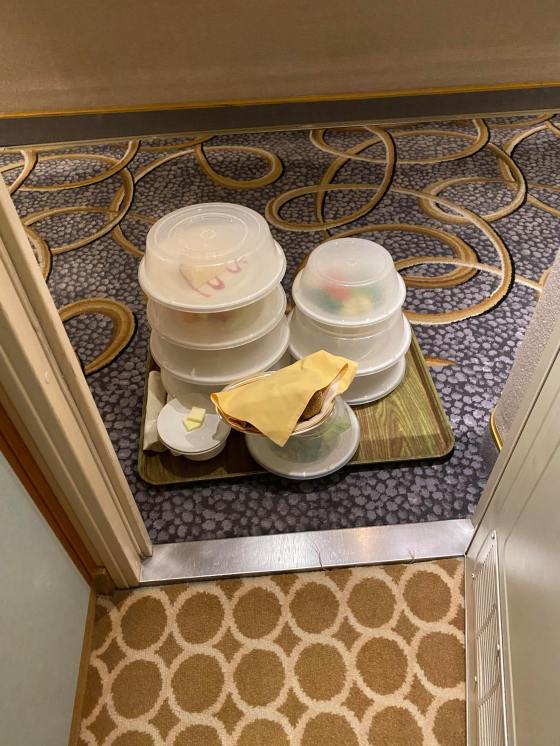Debbie Loftus and her parents were meant to be touring the beauty of Ensenada, in Baja California, Mexico on Thursday, at one of the ports of call for their cruise aboard the Grand Princess.
Instead, the highlight of their day was watching Black Hawk helicopters arriving to drop off kits to test for COVID-19. Loftus and 3,500 other passengers and crew members are currently anchored off the coast of San Francisco after news broke that a passenger who sailed on a previous voyage had died from the deadly infection. The Grand Princess is the latest cruise ship caught up in the outbreak, which has infected nearly 100,000 and killed almost 3,400 people worldwide.
For now, Loftus is keeping a positive attitude. “It was kind of exciting when the helicopters came. We all ran up to get some pictures of that,” says Loftus, a 60-year-old retired physical therapist from Germantown, Wisc.
Shortly after watching the helicopters leave, the passengers returned to their rooms, where they’ve been confined since Thursday afternoon local time. Crew, in masks and gloves, delivered dinner to their cabins.
Loftus says she’s calm, but she’s worried about her parents. They’re in their 80s—a high-risk group for COVID-19—and her mother has asthma. “I don’t want to say it, but if she contracts it, that could be the end for her unfortunately,” Loftus says. “There’s a lot of concern, but we’re not talking about it because we don’t want to worry her too much.”

Threats of a coronavirus outbreak on the Grand Princess have hung over the luxury cruise since Wednesday, when everyone aboard learned that a California man who had been a passenger on a previous voyage died after contracting the coronavirus. The 71-year-old boarded the San Francisco-to-Mexico round-trip cruise on Feb. 11, disembarking on Feb. 21. On Thursday, a second former passenger of the Grand Princess died of a suspected COVID-19 in California.
Read more: Should You Cancel Travel Plans Amid COVID-19 Concerns? Here’s What to Consider
Officials said 62 passengers stayed on the ship after Feb. 21 for the round-trip cruise from San Francisco to Hawaii that was meant to return via Mexico. As of Thursday, at least 35 people are experiencing symptoms, according to Mary Ellen Carroll, executive director of San Francisco’s Department of Emergency Management.
Princess Cruises said in a statement that samples have been collected from 45 people, meaning that not all the passengers who were on the cruise with the 71-year-old man were tested.
Test results are expected to be announced Friday. Until then, passengers are living in limbo, unsure of whether their cruise is virus-stricken—and if they will have to be quarantined.
Loftus says no one on board appears to be panicking, but she suspects that if any of the COVID-19 tests return positive, they will be quarantined.
Another Princes Cruises ship revealed just how quickly the virus can spread on board. Passengers on the Diamond Princess, docked in Japan last month, were stuck in their rooms for 14 days after the cruise learned an earlier passenger had contracted the virus. More than 700 people out of some 3,700 were diagnosed, prompting criticism about the effectiveness of a quarantine that ended with almost one in five people infected. At least six people from the Diamond Princess died.

Loftus believes health authorities and the cruise company have learned from the experience and would do a better job of quarantining passengers if it has to happen again.
For now, though, passengers are anxious about more practical concerns, says passenger Bill Pearce, from Lafayette, Calif. Some are worried about being away from work if there is an outbreak on board. Others aren’t sure if they would be able to get a flight back home.
“If we are quarantined, I think the major options would be to stay on the ship for a period of time, or they could bus us out to Travis base,” he says, referring to the U.S. Air Force base in California that has housed other U.S. coronavirus evacuees under quarantine. “But if they’re not sufficient for everybody, I don’t know what they’re going to do.”
Read more: The Time for Containment Is Over. Welcome to the Next Phase of Coronavirus
Since reports that a previous passenger died of coronavirus, the cruise line has been working to lower the chances of potential transmission. At lunch on Thursday, their last meal before all passengers were sent to their rooms, there were no more shared bread rolls or salt and pepper shakers on dining tables—if you wanted condiments, crew members came around sprinkled them on for you. At buffets, instead of passengers helping themselves at food counters, crew members were on hand to serve food so passengers wouldn’t all be touching the same pair of tongs.
“Outside the restaurants, crew were making sure you wash your hands at the hand washing stations, and use the Purell dispensers,” Pearce, a 54-year-old software engineer on board with his wife says. Before, he adds, passengers could probably get away with walking straight into the restaurants without sanitizing.
And while Loftus appreciates the new measures, she was sad to see that the bar—along with many other facilities on the ship—was already closed on Thursday morning when she tried to buy a bottle of wine.
“We already bought an extra bottle yesterday,” she says. “But we thought we might want to get a bit more if we’re quarantined for 14 days.”
Keep up to date with our daily coronavirus newsletter, and please send tips, leads, and stories from the frontlines to virus@time.com.
No comments:
Post a Comment